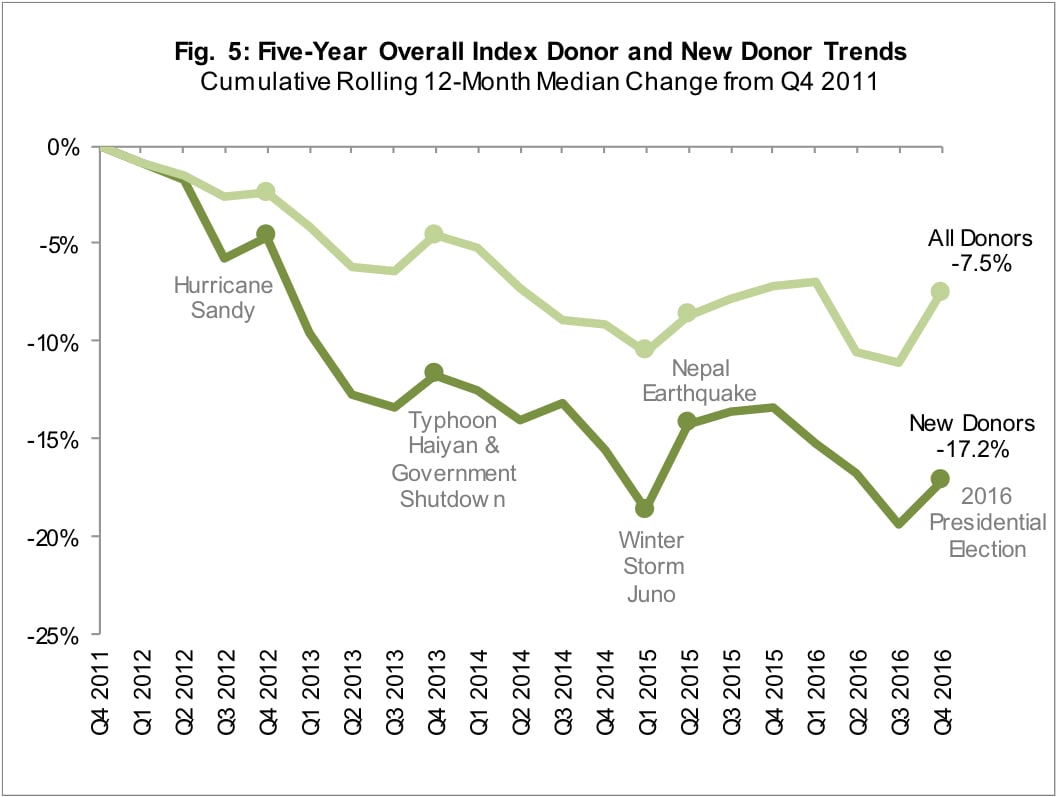 |
| Chad Lucier Vice President, Account Services |
New donor acquisition ain’t what it used to be.
While it’s a road that continues to be traveled by most nonprofits, it’s filled with more bumps and potholes than ever, as evidenced by the Blackbaud donorCentrics Index:

There is some positive news: nearly ½ of all organizations realized a positive change in 2016 and the median decline was only -1.2%.
Regardless of whether you’re in the 51% on the decline or in the lucky 49%, here are a few ideas that might help rev up your new donor acquisition program:
1. Invest in paid search
The Chronicle of Philanthropy ran an article several years ago that has always stuck with me.
It stated that four out of every five donors research an organization before donating. I imagine this is even truer for new donors than existing donors. This means that optimizing your Google grants and paid search investments will ensure that your prospective donors not only find you, but that they get the message you want.
More importantly, a good paid search strategy is critical to capitalize on the awareness and intent being created by all of your on-line and off-line efforts.
If you want to read more about digital acquisition, check out Jeff Ostiguy’s blog post.
2. Consider insert media
Insert media utilizes 3rd party companies and publications to distribute your offer directly to individuals. This can take the form of anything from statement stuffers to catalog bind-ins to newspaper inserts.
Insert media has one distinct advantage over direct mail. Because there is no postage or addressing involved, the cost to produce and distribute insert media is significantly less than direct mail. As a result of those low costs, you can reach a much larger audience and deliver a significant number of impressions.
Although response is significantly lower than direct mail, those cost savings can result in a similar upfront CPDR and by all indications life time value is just as strong. For one client we’ve seen a 20% improvement in the CPDR.
If you’ve maxed out your direct mail acquisition efforts, insert media may provide the incremental gains needed to get back on the path to growth.
3. Use back-end premiums to boost response
Back-end premiums are growing in popularity; most insert media packages utilize them, many DRTV spots offer one for becoming a monthly donor and Peer-to-Peer campaigns are using water bottles, fleece jackets and the like to promote higher gift levels.
More organizations are using them in the mail to effectively increase response rates, and in some cases average gift size.
In three separate client tests, back-end premiums drove significant improvements. Response rates increased by a minimum of 20% and average gift improved by as much as 25%.
If you haven’t tested a back-end premium in the mail, maybe it’s time. I also recommend testing the price point right out of the gate since it can greatly influence both response and average gift.
4. Consider front-end premiums, too
Hate them all you want. But there’s a reason a majority of organizations use them: they drive response. In many cases those address labels or note cards will increase the number of donors at both ends of the giving spectrum.
Below is one recent example of where a premium was tested against a non-premium and resulted in more new donors at all gift levels.
Compared to the non-premium, the premium generated:
70% increase in $15+ gifts
49% increase in $25+ gifts
10% increase in $50+ gifts
The average gift was $28 for the non-premium and $21 for the premium, which as you can see, can be very misleading. A gift distribution is critical to understanding the value of your premium based acquisition package.
If you aren’t using front-end premiums, they are worth another look.
5. Use non-premiums for higher value donors
A non-premium based acquisition package won’t increase the number of new donors at the same rate as premium packages. But package costs are low and lifetime value is high so there are plenty of reasons to incorporate non-premiums into your new donor strategy.
To get the most out of your non-premium strategy, make sure you reinvest those cost savings.
While costs vary widely, many non-premium packages cost $100/M less than a premium-based package.
If you are mailing five million non-premium packages, that is $500,000 that you can reinvest in either increased volume or one of the other strategies noted above. By doing so you may actually reap the benefits of both a larger and more valuable donor universe.
Like a balanced portfolio of stocks and bonds, a combination of premium and non-premium acquired donors will typically yield the best balance between growth and value.
6. Retarget website visitors
Most organizations are retargeting their website visitors with banner ads … but how many are retargeting those visitors with direct mail appeals?
By all accounts, retailers and other commercial organizations are successfully using direct mail to convert web site visitors to customers. This usually takes the form of a postcard featuring a product that you browsed online. While application and execution may be different for non-profits, it is an exciting opportunity nonetheless.
Although this is fairly new to the non-profit space, the potential exists to convert a number of returning visitors or donation page abandoners into donors. This could be especially meaningful for organizations with significant web traffic.
At the very least, this is a new way to target a warm prospect universe.
Which brings us to…
7. Don’t neglect warm prospects
The path to growth isn’t always through new donors. Sometimes it is more productive to mine the event names or memorial donors that are on your own database than it is to acquire a new donor.
The trick is in identifying the ones most likely to respond. For some ideas on the matter, I encourage you to read Brian Murphy’s recent post about uncovering the buried treasure in your database.
What did I miss? Please share your thoughts and ideas about how to rev up your acquisition program by clicking here.





